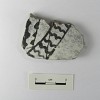
| Culture | Branch | Tradition | Ware | Type |
| Ancestral Pueblo: Southern Colorado Plateau (Anasazi) | Central Anasazi | Chuska | Chuska White Ware (Mineral Paint) | Naschitti Black-on-white |
Type Name: Naschitti Black-on-white |
|
| Period: | 900 A.D. - 1050 A.D. |
| Culture: | Ancestral Pueblo: Southern Colorado Plateau (Anasazi) |
| Branch: | Central Anasazi |
| Tradition: | Chuska |
| Ware: | Chuska White Ware (Mineral Paint) |
First posted by C. Dean Wilson 2012
Naschitti Black-on-white was defined by Wilson and Peckham (1964). This type is assigned to white wares tempered with trachyte and with styles commonly used to define Red Mesa Black-on-white (Reed and others 1998; Windes 1977). This type is present in assemblages dating to the tenth, and at least the first half, if not all, of the eleventh century.
Paste is white, gray, to dark gray. Surfaces are sometimes not slipped and sometimes covered with a chalky-white polished slip. Decorations are applied in a thick black to brown mineral paint. Decoration is almost identical to that described for Red Mesa Black-on-white although lines may sometimes be thicker. Designs consist of multiple parallel lines sometime embellished with triangles or ticked lines, ribbons, checkerboard patterns, widely spaced straight hachure, scalloped or ticked triangles, and scrolls. Similar pottery exhibiting squiggle hachure is sometimes used to define Burnham Black-on-white but is considered here as part of the variation associated with Naschitti Black-on-white. Painted designs are often well executed, and different elements often occur together in fairly complex patterns. As is the case for Red Mesa Black-on-white, several distinct motifs are often combined together to produce several distinct and repeating design combinations in a banded, quartered, or all over design layouts. Repeating designs are often organized in evenly spaced design patterns that are often, separated by a series of parallel lines often producing a distinct precisely executed and well organized pattern of intricate and opposing designs. Vessel forms are represented by a wide range and relatively even mixture of jar and bowl forms that also include pitchers, ladles, and effigies.
References:
Reed, Lori S., Joell Goff, and Kathy Niles Hensler
1998 Exploring Ceramic Production, Distribution, and Exchange in the Southern Chuska Valley: Analytical Results from the El Paso Natural Gas North Expansion Project, Pipeline Archaeology 1990-1993: The El Paso Natural Gas System Expansion Project, New Mexico and Arizona, Vol XI, Book 1, Report no, WCRM (F)74, Farmington.
Wilson, John P., and Stewart Peckham
1964 Chuska Valley Ceramics. Manuscript on file, Laboratory of Anthropology, Museum of New Mexico, Santa Fe.
Windes, Thomas C.
1977 Typology and Technology of Anasazi Ceramics. In Settlement and Subsistence Along the Lower Chaco River, edited by C. Reher, pp 270-369. University of New Mexico, Albuquerque.
Related Photos
 © New Mexico Office of Archaeological Studies, a division of the New Mexico Department of Cultural Affairs.
© New Mexico Office of Archaeological Studies, a division of the New Mexico Department of Cultural Affairs.
The Center for New Mexico Archaeology
7 Old Cochiti Road
Santa Fe, NM 87507
505-476-4404
Fax: 505-476-4448






